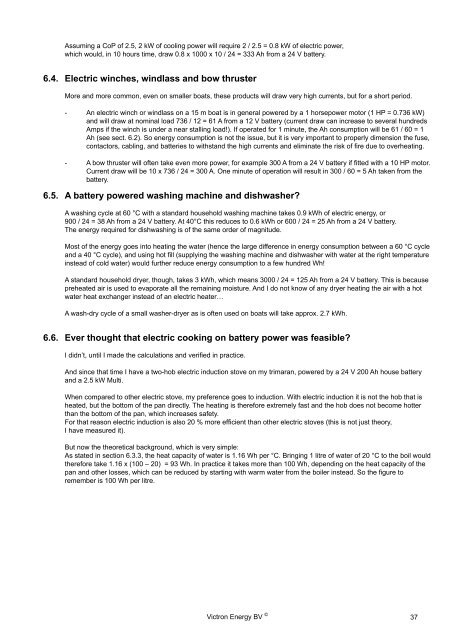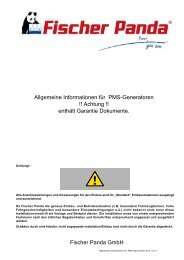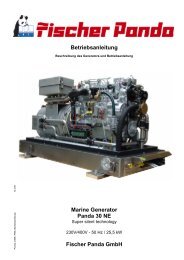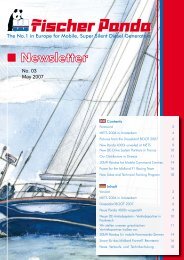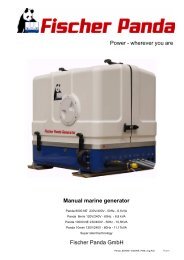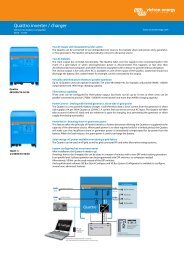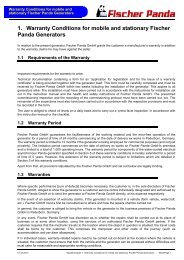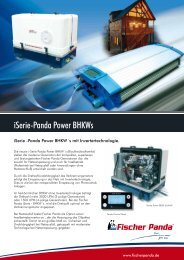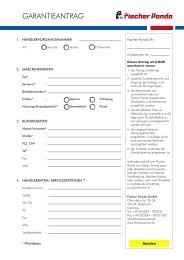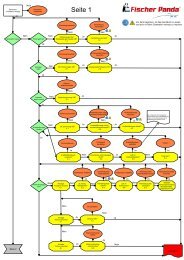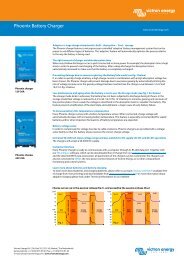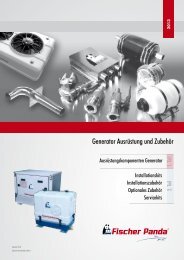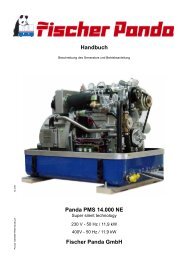Victron "Energy Unlimited" - Utu
Victron "Energy Unlimited" - Utu
Victron "Energy Unlimited" - Utu
Create successful ePaper yourself
Turn your PDF publications into a flip-book with our unique Google optimized e-Paper software.
Assuming a CoP of 2.5, 2 kW of cooling power will require 2 / 2.5 = 0.8 kW of electric power,<br />
which would, in 10 hours time, draw 0.8 x 1000 x 10 / 24 = 333 Ah from a 24 V battery.<br />
6.4. Electric winches, windlass and bow thruster<br />
More and more common, even on smaller boats, these products will draw very high currents, but for a short period.<br />
- An electric winch or windlass on a 15 m boat is in general powered by a 1 horsepower motor (1 HP = 0.736 kW)<br />
and will draw at nominal load 736 / 12 = 61 A from a 12 V battery (current draw can increase to several hundreds<br />
Amps if the winch is under a near stalling load!). If operated for 1 minute, the Ah consumption will be 61 / 60 = 1<br />
Ah (see sect. 6.2). So energy consumption is not the issue, but it is very important to properly dimension the fuse,<br />
contactors, cabling, and batteries to withstand the high currents and eliminate the risk of fire due to overheating.<br />
- A bow thruster will often take even more power, for example 300 A from a 24 V battery if fitted with a 10 HP motor.<br />
Current draw will be 10 x 736 / 24 = 300 A. One minute of operation will result in 300 / 60 = 5 Ah taken from the<br />
battery.<br />
6.5. A battery powered washing machine and dishwasher<br />
A washing cycle at 60 °C with a standard household washing machine takes 0.9 kWh of electric energy, or<br />
900 / 24 = 38 Ah from a 24 V battery. At 40°C this reduces to 0.6 kWh or 600 / 24 = 25 Ah from a 24 V battery.<br />
The energy required for dishwashing is of the same order of magnitude.<br />
Most of the energy goes into heating the water (hence the large difference in energy consumption between a 60 °C cycle<br />
and a 40 °C cycle), and using hot fill (supplying the washing machine and dishwasher with water at the right temperature<br />
instead of cold water) would further reduce energy consumption to a few hundred Wh!<br />
A standard household dryer, though, takes 3 kWh, which means 3000 / 24 = 125 Ah from a 24 V battery. This is because<br />
preheated air is used to evaporate all the remaining moisture. And I do not know of any dryer heating the air with a hot<br />
water heat exchanger instead of an electric heater…<br />
A wash-dry cycle of a small washer-dryer as is often used on boats will take approx. 2.7 kWh.<br />
6.6. Ever thought that electric cooking on battery power was feasible<br />
I didn’t, until I made the calculations and verified in practice.<br />
And since that time I have a two-hob electric induction stove on my trimaran, powered by a 24 V 200 Ah house battery<br />
and a 2.5 kW Multi.<br />
When compared to other electric stove, my preference goes to induction. With electric induction it is not the hob that is<br />
heated, but the bottom of the pan directly. The heating is therefore extremely fast and the hob does not become hotter<br />
than the bottom of the pan, which increases safety.<br />
For that reason electric induction is also 20 % more efficient than other electric stoves (this is not just theory,<br />
I have measured it).<br />
But now the theoretical background, which is very simple:<br />
As stated in section 6.3.3, the heat capacity of water is 1.16 Wh per °C. Bringing 1 litre of water of 20 °C to the boil would<br />
therefore take 1.16 x (100 – 20) = 93 Wh. In practice it takes more than 100 Wh, depending on the heat capacity of the<br />
pan and other losses, which can be reduced by starting with warm water from the boiler instead. So the figure to<br />
remember is 100 Wh per litre.<br />
<strong>Victron</strong> <strong>Energy</strong> BV ©<br />
37


